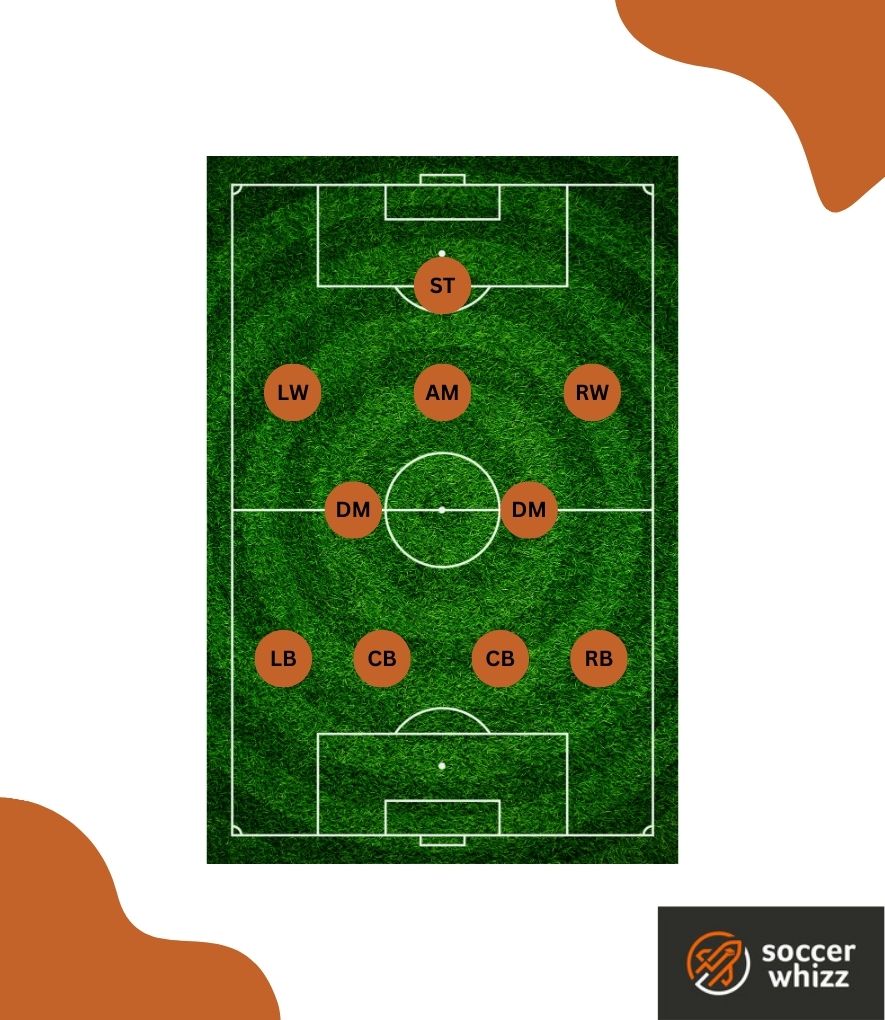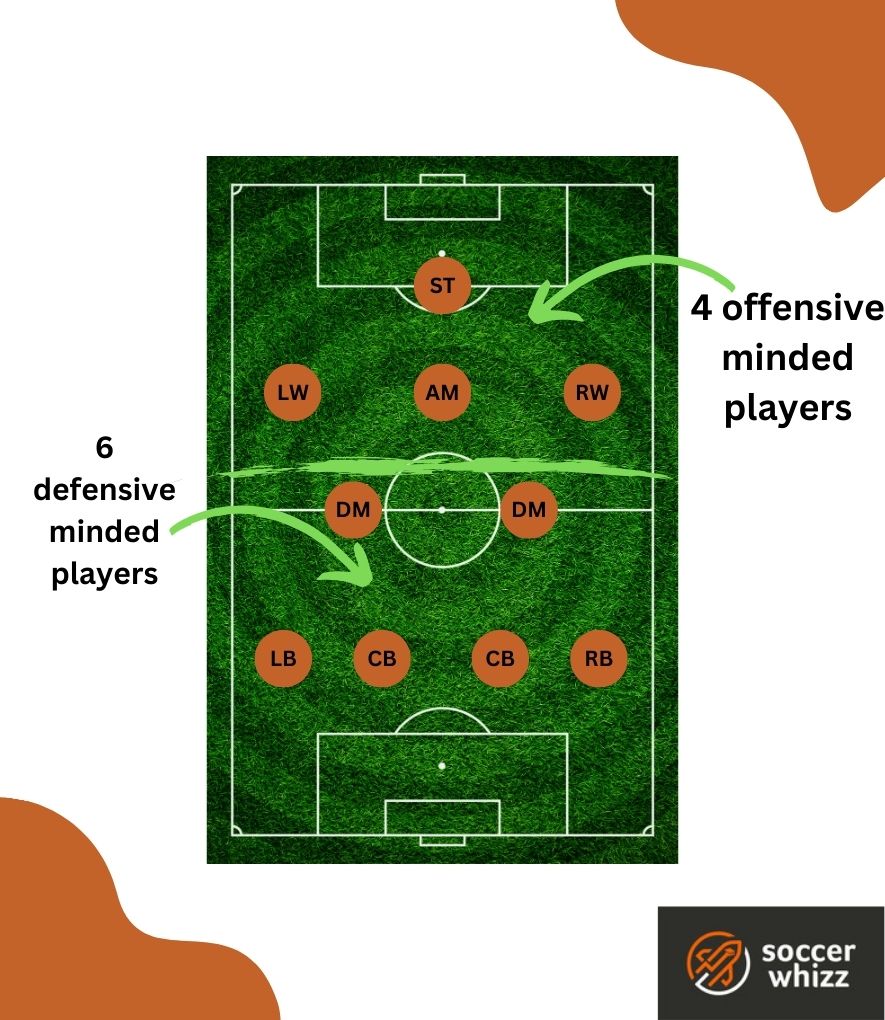In the ever-changing world of soccer, the art of tactics and strategy plays a pivotal role in determining the success of a team on the pitch.
Among the myriad of formations at a coach’s disposal, the 4-2-3-1 stands tall as a formation that has revolutionized the way modern football is played.
With its dynamic structure and versatility, the 4-2-3-1 has become a go-to choice for many top-tier clubs and national teams worldwide.
In this comprehensive guide, we delve deep into the intricacies of the 4-2-3-1 soccer formation, exploring its origins, key principles, and tactical nuances that have made it a formidable force on the global stage.
From its historical evolution to its practical implementation on the pitch, we unlock the secrets behind its overwhelming success and the reasons behind its popularity among managers and players alike.
- How does the 4-2-3-1 formation work?
- What are the strengths of the 4-2-3-1 formation?
- What are the weaknesses of the 4-2-3-1 formation?
- Which soccer managers successfully used the 4-2-3-1 shape?
- Why is this tactical shape so popular?
- Is the 4-2-3-1 the most commonly used soccer formation?
- Concluding thoughts
How does the 4-2-3-1 formation work?
The 4-2-3-1 formation comprises a solid defensive back four, flanked by two defensive midfielders, and an advanced midfield trio, which includes wide midfielders, supporting a lone central striker.

This tactical setup is frequently favored by possession-oriented teams seeking to control the game by evenly spreading players across the pitch.
By employing five midfielders, the 4-2-3-1 formation achieves a well-balanced distribution.
The two defensive midfielders can focus on protecting the backline and orchestrating ball progression, while the trio of midfielders in front concentrates on assisting the lone striker and generating scoring opportunities.
The versatility of the midfield three is a key aspect, as they exhibit fluidity in their positioning, interchanging roles, and pushing into more advanced areas to establish connections with the center forward.
Such flexibility is vital to avoid isolating the lone striker, ensuring he receives the support needed to challenge the opposition’s defense effectively.
Additionally, the midfielders play a crucial defensive role, as they are responsible for pressing the opposing defenders and disrupting their efforts to advance the ball up the field, thereby maintaining pressure and control in crucial midfield areas.
What are the strengths of the 4-2-3-1 formation?
The 4-2-3-1 formation’s surge in popularity over the last 15 years can be largely attributed to the exceptional balance it offers on the field.
The combination of a solid back four alongside two central defensive midfielders ensures a strong defensive foundation for teams adopting this tactical setup.

Even when the full-backs venture forward to support attacks, the presence of the double pivot in central midfield and two center-backs deeper provides ample defensive cover.
Pushing the full-backs upfield not only creates width in advanced areas but also compels opposition wingers to track back and contribute defensively.
The formation’s most crucial advantage lies in its ability to facilitate ball retention and buildup play.
Utilizing the back four as a starting point to progress the ball forward, the two central defensive midfielders serve as reliable outlets, efficiently connecting the defense with the attack.
The five midfielders can spread wide, form intricate passing triangles, and dominate possession, allowing the team to maintain control for prolonged periods.
However, the 4-2-3-1 is far from being a passive formation.
Despite its possession-oriented strengths, it can also be deployed aggressively.
With the central defensive midfielders providing cover, the three advanced midfielders can press high, effectively becoming forwards themselves, resulting in a dynamic front four capable of creating havoc in opposing defenses.
This fluid and aggressive style involves pressing high, winning possession, and fluidly interlinking as a formidable attacking force. When executed effectively, the 4-2-3-1 can be a daunting challenge for opponents to handle.
What are the weaknesses of the 4-2-3-1 formation?
The 4-2-3-1 formation relies heavily on continuous communication and unwavering dedication from every player involved.
To maintain a cohesive and organized structure, constant instructing and advising among teammates are imperative throughout the game.
This communication aspect holds particular significance for the two central defensive midfielders (CDMs), who bear the responsibility of remaining defensively disciplined while offering passing options to their teammates in possession.
The central midfield area can become crowded or tight in a 4-2-3-1 formation.
However, with effective communication during matches, this potential issue can be mitigated, making it less of a major concern.
The wide midfield areas also demand special attention.
To avoid becoming weak links in the team, the wider midfielders need to possess speed and skill in one-on-one situations.
Their responsibilities encompass linking up with the striker to create scoring opportunities, pressing aggressively to disrupt opposition defenders, and diligently tracking back when necessary.
Overall, the success of the 4-2-3-1 formation hinges on the seamless communication and hard work of each player on the pitch.
By embracing their roles, staying disciplined, and collaborating effectively, teams can unlock the full potential of this dynamic tactical setup.
Which soccer managers successfully used the 4-2-3-1 shape?
Three reputable managerial names immediately spring to mind here…
1. Mauricio Pochettino
Pochettino’s 4-2-3-1 formation showcased a dynamic attacking setup that revolved around Harry Kane as the central striker.

Dele Alli took on the role of a penetrative number 10, consistently making forward runs beyond Kane to stretch the opposition’s defense.
Son Heung-min also contributed with his incisive movements, particularly during transition phases when he sought opportunities to break through the defensive lines.
2. Hansi Flick
In Bayern’s triumphant 2019/20 Champions League campaign under Flick’s guidance, the 4-2-3-1 formation proved to be exceptionally potent.

Their impressive victories against Chelsea (7-1 on aggregate) and Barcelona (8-2 aggregate score line), along with a dominant 7-2 win over Tottenham during the group stage where Serge Gnabry scored four goals, exemplified the formation’s effectiveness.
The focal point of the attack was the prolific Robert Lewandowski, leading the line as the center-forward.
Supporting him was the dynamic and versatile Thomas Müller, who expertly made well-timed runs beyond the striker, offering additional presence in the box to capitalize on crosses.
Moreover, Müller’s role saw him skilfully rotating positions with the wide players, namely Kingsley Coman, Ivan Perisic, and Serge Gnabry, as they masterfully transitioned infield towards the goal.
3. Pep Guardiola
During the 2020/21 season, Guardiola prominently employed the 4-2-3-1 formation at Manchester City, utilizing it more frequently than in any of his previous seasons.

The midfield’s core featured a double pivot, consisting of Rodri and either Ilkay Gündogan or Fernandinho, effectively shielding the area ahead of the back four.
Interestingly, the back line often adapted into a three-man defensive setup, with João Cancelo actively advancing infield from the left-back position.
This tactical adjustment allowed City to reinforce their attacking options while maintaining defensive solidity.
Why is this tactical shape so popular?
The 4-2-3-1 formation has gained immense popularity in modern football due to several key factors that make it an attractive tactical choice for many teams:
Balance
The 4-2-3-1 provides an excellent balance between defense and attack.
With four defenders, two central defensive midfielders, and an advanced midfield trio supporting a lone striker, the formation spreads players across the pitch in a well-structured manner, ensuring defensive stability while offering significant attacking options.
Versatility
The formation is highly versatile and can adapt to different playing styles and strategies.
Teams can use it to dominate possession, control the midfield, press aggressively, or play on the counter-attack, making it suitable for various tactical approaches.
Attacking potential
The 4-2-3-1 allows for an array of attacking options.
The attacking midfielder and wide players provide creative flair, while the lone striker can be supported by the advanced midfielders and full-backs, creating a fluid and potent attacking force.
Is the 4-2-3-1 the most commonly used soccer formation?
The 4-2-3-1 stands as one of the most favored and effective formations in contemporary football. Its combination of attacking prowess and defensive resilience made it a prominent choice during major tournaments like the 2010 FIFA World Cup and Euro 2012.
In this tactical setup, the full-backs exhibit qualities reminiscent of those seen in a 4-3-3 formation—exuding explosiveness, speed, and a willingness to venture forward and support the team’s attacking endeavors.
Concluding thoughts
To wrap everything up, the 4-2-3-1 formation has undeniably etched its place as a tactical masterpiece in modern football.
With its blend of defensive solidity, attacking flair, and strategic flexibility, this formation has captured the imagination of coaches, players, and fans worldwide.
Throughout our exploration of its origins, principles, and tactical nuances, it becomes evident that the 4-2-3-1 offers a versatile canvas upon which teams can paint their own unique playing styles.
Should you wish to read about similar tactical shapes, have a look at our articles on:
If you enjoy the content that I create and would like to buy me a coffee, then I’d really appreciate it!
Any money that I earn through this donation will be re-invested into more content for this website.
Additionally, by sending in a donation you’ll also receive a copy of my recently released 190+ page eBook on Soccer Ball Care, as well as be subscribed to our mailing list where you’ll be regularly informed on the latest developments concerning the Soccer Whizz blog.
- Future Icons: Europe’s Emerging Midfield Maestros Set for Glory - December 4, 2023
- Kickstarting a Revolution: How Soccer Transformed the United States Over the Last Four Years - October 7, 2023
- 4-1-4-1 Soccer Formation [Analysis] - September 23, 2023

